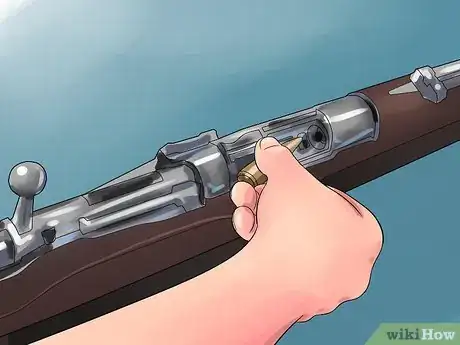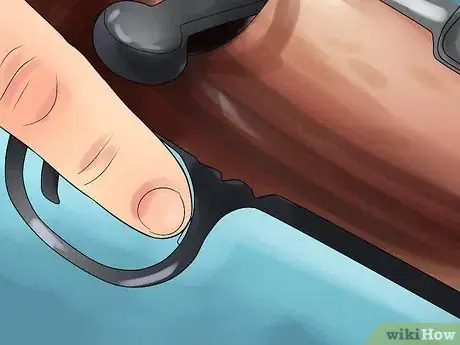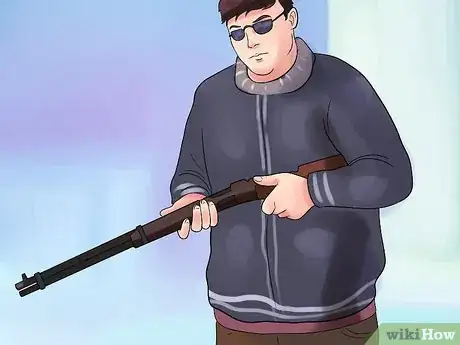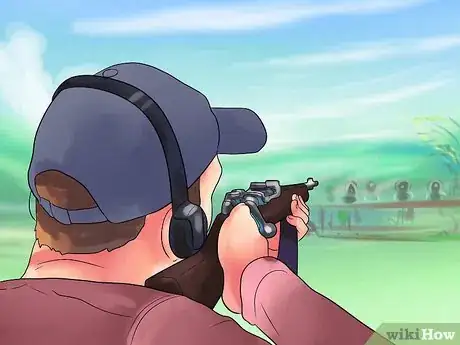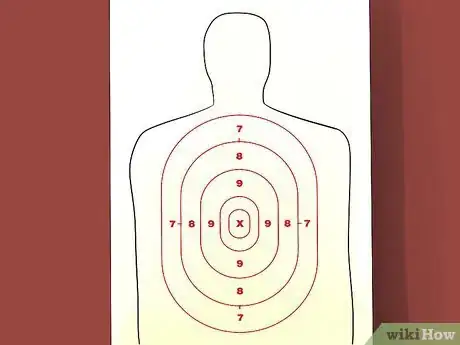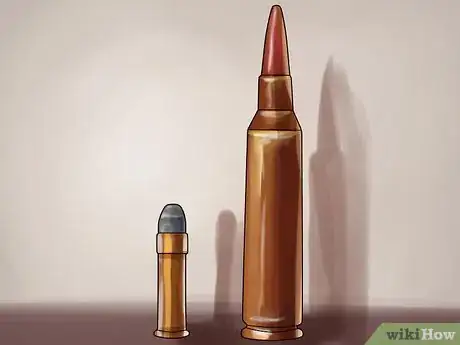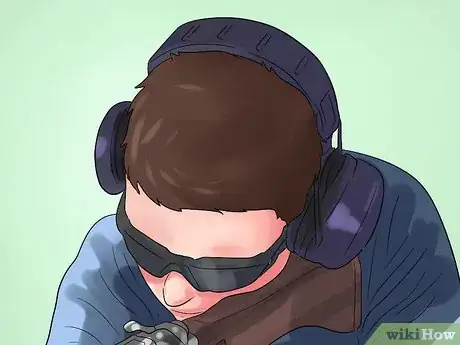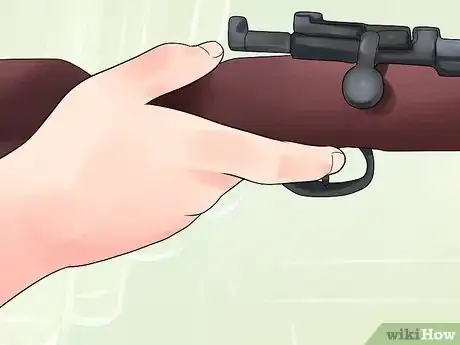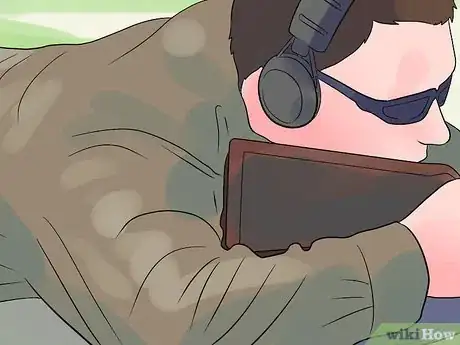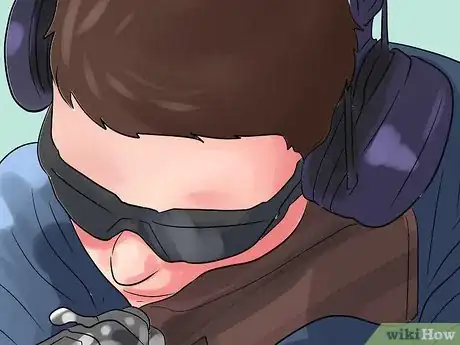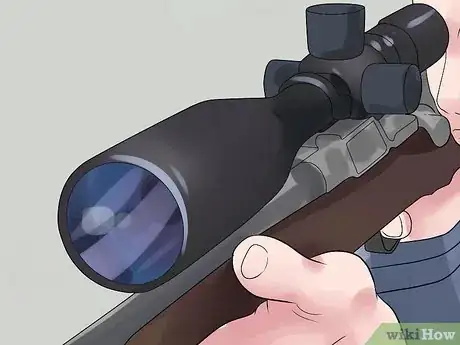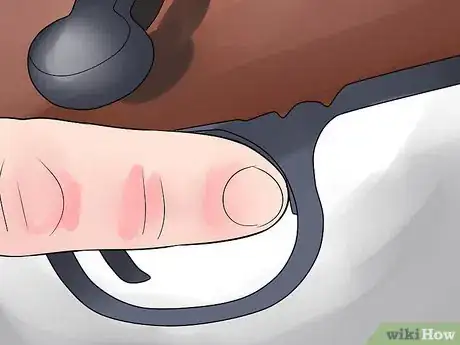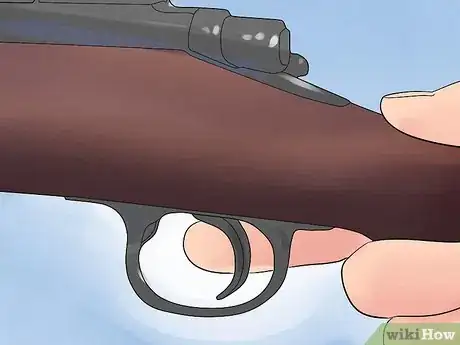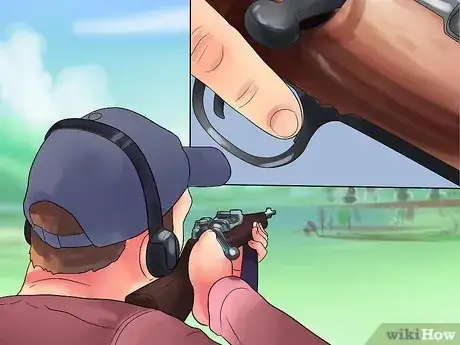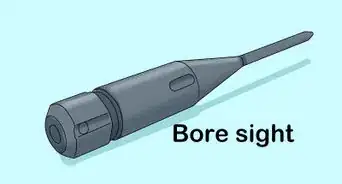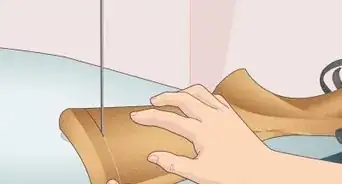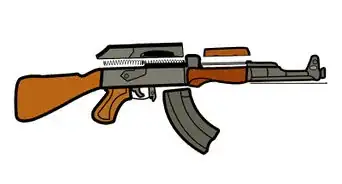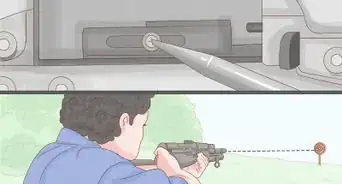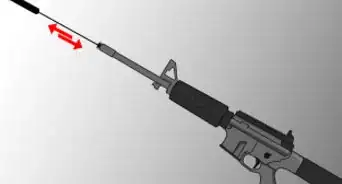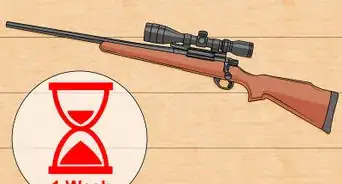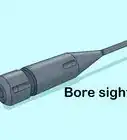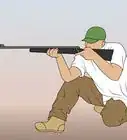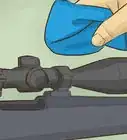wikiHow is a “wiki,” similar to Wikipedia, which means that many of our articles are co-written by multiple authors. To create this article, 13 people, some anonymous, worked to edit and improve it over time.
This article has been viewed 42,840 times.
Learn more...
Forget what you think you know from video games and movies: learning to fire a rifle properly requires practice, preparation, and safety. Learning the basics of form will help you develop the right fundamentals to make accurate and safe shots with a rifle, whether you want to shoot for sport or hunting purposes. Learn to be safe and aim properly and you'll be making the right shots.
Steps
Handling a Rifle Safely
-
1Understand how the gun is loaded. Different rifles are operated in different ways, and since the first thing you need to do upon picking up a rifle is check to see if it's loaded, you need to learn how to load and unload different kinds of rifles.[1] While specific models, brands, and styles will vary widely, there are two basic varieties of rifles that you'll encounter:
- Bolt-action rifles fire when a sliding bolt is manually operated to advance and eject the ammunition casings, which are fed into the firing chamber from a magazine, or loaded directly into the firing chamber, one round at a time.
- Semi-automatic rifles are also magazine-fed, but advance each round into the chamber automatically after a round is fired. To advance the first round into the chamber, you need to usually pull back a small bolt, much like on a bolt-action rifle.
-
2Check to make sure the gun is unloaded. Each and every time you pick up the gun, you need to check it to see whether or not it's loaded and make sure the safety is on. Most safeties will be located just to the front of the trigger guard, though some will be placed elsewhere. Check the owner's guide for the specific rifle you're firing to make sure you know where the safety is located.
- To check if a bolt-action rifle is unloaded, make sure the safety is on, then pull the bolt backward. Remove the magazine, if necessary. If you see there is nothing in the firing chamber, and the magazine it out, the gun is unloaded.
- To check if a semi-automatic rifle is unloaded, remove the magazine if necessary, and pull the bolt on the rifle back. Look into the firing chamber to ensure nothing is present. If there isn't, and the magazine is out, the gun is unloaded.
Advertisement -
3Treat the firearm as if it is loaded at all times. The single basic rule of gun safety is to treat all firearms as if they were loaded, at all times. Every time you pick up a rifle, you need to check to see if it's loaded. Every time you put down a rifle, you need to check to see if it's loaded. Even after checking to see if the gun is loaded, you treat the gun as if it were. This is the only way to ensure that accidents don't happen.
- Keep the safety on at all times when you're handling the rifle. Never switch the safety off unless you've aimed the gun in a safe direction, are holding the gun securely, and are about to fire the rifle.
- Keep the barrel of the gun pointed downrange at all times. When you're firing a rifle, never point the gun in the direction of anyone, or swing the gun around horizontally. The barrel of the rifle should be pointed in a safe direction whenever you pick it up.
- Keep your finger off the trigger. Whenever you're handling the gun, even when the safety is on, you need to keep your finger clear of the trigger. Never move your finger into position to fire the rifle until you've aimed the gun in a safe direction, have turned the safety off, and are ready to fire.
-
4Only fire rifles at designated areas. Rifles need to be fired at shooting ranges, gun clubs, or on private property with sufficient safe space for shooting. Rifle rounds can travel long distances, making it absolutely essential that you only shoot rifles in areas in which you're sure of what's beyond the target.
- Shooting ranges and gun clubs are usually the easiest ways of shooting rifles, providing specific ranges, with a variety of targets and distances for you to practice. Find a gun club in your area that you can join for target practice.
-
5Select an appropriate target and be sure of what is behind it. Again, the best way to practice shooting your rifle is at well-kept and maintained shooting ranges, at which you can be sure of the safety of the targets and the backdrops at which you're firing.
- Paper targets are the best way to test your accuracy, and should be backed with earth-mounds or other professional backing that will help to trap the bullet and decrease the possibility of a ricochet.
- Steel targets offer a distinctive "ping" when shot accurately, and are actually safer than it may seem. Steel targets should be angled and only shot while wearing safety goggles. While all targets present the possibility of ricochet injury, properly maintained steel targets at the appropriate distance don't ricochet more than other types of targets.[2]
- Targets need to be at least 20–50 yards (18.3–45.7 m) away, or preferably more. Most rifle ranges have a variety of target distances. "Long" range starts around 100 yards (91.4 m).[3] Cartridges will also provide a minimum safe shooting distance, which you should always extend slightly. If it says 25 yards (22.9 m), chalk that up to 30 to be safe.
-
6Use ammunition appropriate for the rifle you're firing. Rifle cartridges are measured in terms of caliber, which refers to the diameter of the individual cartridges, which should match the diameter of the inside of the rifle's barrel. Depending on the rifle you have access to, you need to use only the size of ammunition that matches the rifle.
- If you're trying to buy a rifle, the most common calibers of rifle are usually .22 and .30. .22 rifles are a good first gun.
-
7Always wear proper safety equipment. Any time you're firing a rifle, it's important to have the proper safety equipment in place. Gun safety requires good practices and also good protective equipment to keep everyone safe.
- Safety glasses should be worn at all times when firing rifles. If you wear glasses, it's still a good idea to wear polycarbonate safety goggles over them.
- Hearing protection, including ear plugs and more substantial wrap-around ear protection, needs to be used at all times, especially in shooting galleries, in which lots of people are firing at once.
Aiming a Rifle
-
1Find your steady position. In marksmanship training, soldiers are required to hold their rifles so steady a hammer could fall on the barrel and the shot would still be accurate. Shooting is a matter of form, not luck or muscle strength. Practice shooting from different positions and find the one you feel most comfortable firing from, then keep practicing the others anyway. Good marksmanship involves being comfortable shooting from any of the following positions, with the basic fundamentals of shooting in place:
- Standing position. In this position, you'll stand with the hip of your non-trigger hand pointing at the target, and will support the rifle with your elbows in tight to your torso to make it as comfortable as possible. This is the most difficult position from which to make accurate shots.
- Kneeling position. This is a steady position that allows you to balance your supporting hand on your knee, making it one of the most comfortable and steady positions from which to shoot.
- Sitting position involves sitting cross-legged, balancing both the shooting and the supporting elbows on each of your knees. While the sitting position is somewhat less comfortable than it may seem, it's extremely secure, especially if you can control your breathing.
- Prone position. This is the most accurate shooting position for many shooters, offering you the most support possible, allowing you to use your close proximity to the ground to steady yourself.
-
2Hold the handgrip in your trigger hand. When you pick up the gun, always be sure to check and double-check that the gun is unloaded. Only load the gun when you're set and ready to fire. Pick up the gun, keeping the barrel pointed downrange, and place your hands on the handgrip and the stock correctly.
- Hold the handgrip, just behind the trigger, with your dominant hand. Keep your hand well back of the trigger when you’re first getting situated. Your finger should be nowhere near the trigger.
-
3Balance the stock in your supporting hand. Up-turn your palm and use your fingers to create a “V” with your steadying hand. Seat the stock of the gun into your supporting hand, about halfway between the barrel of the gun and the trigger. Experiment some with your grip to get a sense of what's most comfortable for you.
- Expert rifle marksmen generally support the rifle fairly close to the trigger guard, because it'll strain your muscles less to hold the gun upright.
-
4Pull the butt of the rifle into the pocket of your shoulder. While rifles don't kick anything like shotguns, it's still important to secure the rifle in the pocket created by your shoulder and armpit, pulling it firmly into the muscle just inside of your shoulder. It should neither be resting against your gun nor your shoulder bone, but the muscle that connects them.
-
5Drop your cheek to the rifle. After you've taken hold of the gun properly, get into firing position and maintain what's called "cheek to stock weld." Holding the gun properly, you should be able to let your head fall over gently to the side, letting your cheek rest against the butt of the rifle and align your eye with the sights. If you need to readjust some, carefully readjust and resettle yourself to make the position comfortable.[4]
-
6Align the rifle sight. Once your eye is aligned, you need to learn to aim the gun properly. The process is slightly different, depending on the variety of sighting mechanism included with your rifle. Some rifles have telescopic sights, commonly referred to as "scopes" while other rifles feature simpler bead-style sights on the top of the barrel.
- Bead-style sights are aimed by lining up the bead at the very end of the barrel even with the port farther back on the gun. The bead at the end needs to be the same height and just between the "V" created by the port. Usually, these are marked with green or red luminescent dots. When you're firing, focus your eye on the bead, not on the target itself.
- Telescopic sights are like telescopes mounted on the top of the barrel, which usually feature a cross-hair style sight imposed on the magnified image. Shooting involves lining up the point at which the lines cross and training it directly on what you want to shoot. It'll take some practice to line up your eye accurately with the sight, staying far enough back to get an accurate sight picture.
Shooting Accurately
-
1Control your breathing. Lots of chatter is given to breathing while you shoot, but the actual process goes a lot more smoothly the less you think about it. Breathe naturally and comfortably, taking full and normal breaths, then fire immediately after exhaling.
- Fire in the second immediately following an exhale for the most accurate shot. Studies show you're at your steadiest as soon as air is expelled from your lungs.
- Never "hold your breath" to fire. Holding your breath creates an automatic and unconscious waver in your body, as it reacts to being deprived of oxygen. It's less accurate than a shot fired immediately after an exhale.
-
2Switch off the safety. When you're aimed and ready to shoot, load the gun and make sure the field is clear of people and obstacles. It's common range courtesy to let everyone know that you're about to shoot before you start popping off rounds. When you're ready and steady, it's ok to switch off the safety on the gun.
-
3Squeeze the trigger. Keep aiming and maintain a proper sight picture on the target at which you're aiming. Breathe normally and switch off the safety. Your finger should be outside the trigger guard, resting gently against it. When you're ready and comfortable, move it onto the trigger and squeeze it gently but firmly, then release it and return your finger to the side of the trigger, letting it rest gently.[5]
- Avoid jerking or “pulling” the trigger of the rifle. You want to fire quickly, but a jerky trigger finger can make microscopic changes in your aim, which can be enough to miss widely. Practice squeezing, as if you were trying to pull something just behind the trigger, rather than pull the trigger.
-
4Follow through. It's likely you want to see what you hit, and it's possible to get all excited and want to drop the gun and run down range. Just like in basketball or tennis, your follow-through is important to making accurate shots. Be very careful and stay secure in your position after firing.
- Re-safety the weapon immediately and keep the gun pointed downrange. Most shooting accidents happen immediately after the gun has been fired safely. Continue aiming and staying in your position, then let the gun come back down to rest gently, keeping the barrel pointed down range.
- If you're shooting a bolt-action rifle, you can operate the slide-bolt to eject the spent casing, and rack another into place, if you want to keep shooting. It's a good idea to re-safety the weapon, either way.
Community Q&A
-
QuestionShould I keep one eye open or both eyes?
 Landen RoblinCommunity AnswerIt just depends on what is most comfortable for you and how well you can see through the scope. Experiment in a safe environment.
Landen RoblinCommunity AnswerIt just depends on what is most comfortable for you and how well you can see through the scope. Experiment in a safe environment.
Warnings
- Never point a loaded weapon at anything you do not intend to shoot.⧼thumbs_response⧽
- Always use safety glasses and ear protection.⧼thumbs_response⧽
References
- ↑ http://training.nra.org/nra-gun-safety-rules.aspx
- ↑ http://www.alloutdoor.com/2014/03/10/understanding-safety-steel-targets/
- ↑ https://demigodllc.com/articles/practical-long-range-rifle-shooting-equipment/
- ↑ http://www.armystudyguide.com/content/army_board_study_guide_topics/m16a2/four-fundamentals-of-mark.shtml
- ↑ http://www.outdoorlife.com/blogs/gun-shots/2012/08/shooting-tips-8-mistakes-rob-rifle-accuracy
About This Article
To fire a rifle, start by loading it with the appropriate ammunition. Next, hold the handgrip, which is just behind the trigger, with your dominant hand. Then, seat the stock in your supporting hand, about halfway between the barrel of the gun and the trigger. Lift and pull the butt of the rifle into the pocket of your shoulder, let your cheek rest against the butt, and align your eye with the sights to aim at your target. Finally, switch off the safety and squeeze the trigger. For more tips on how to aim correctly, read on!
